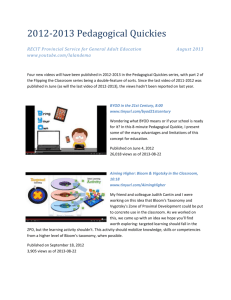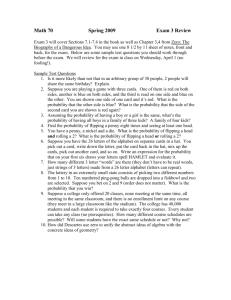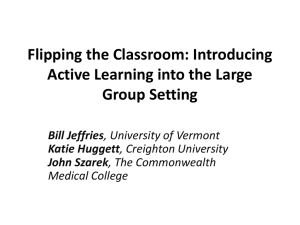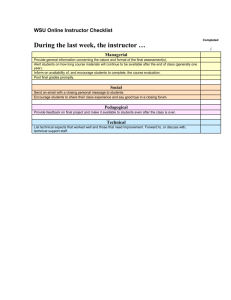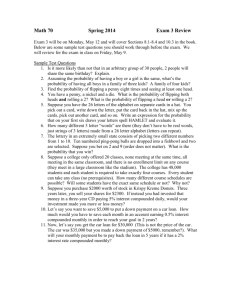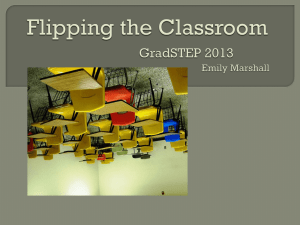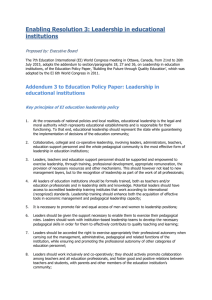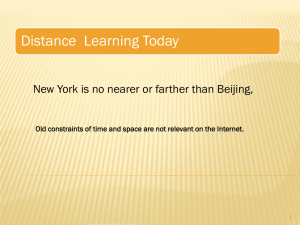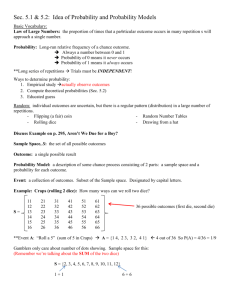Introduction The explosion of online courses, especially at the
advertisement
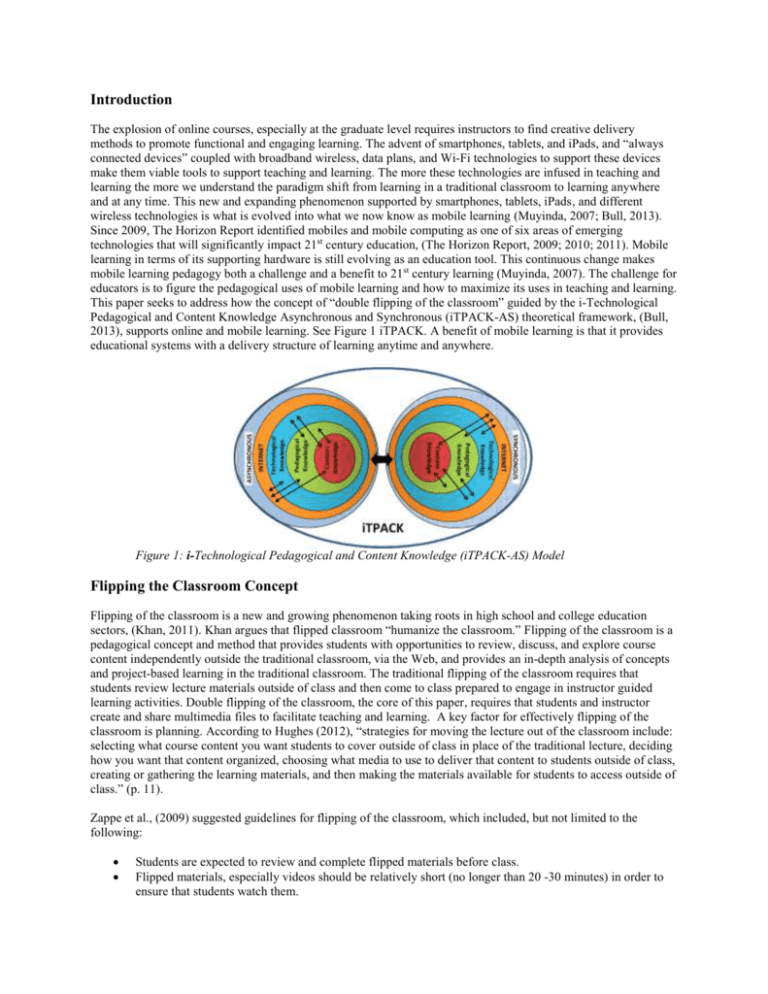
Introduction The explosion of online courses, especially at the graduate level requires instructors to find creative delivery methods to promote functional and engaging learning. The advent of smartphones, tablets, and iPads, and “always connected devices” coupled with broadband wireless, data plans, and Wi-Fi technologies to support these devices make them viable tools to support teaching and learning. The more these technologies are infused in teaching and learning the more we understand the paradigm shift from learning in a traditional classroom to learning anywhere and at any time. This new and expanding phenomenon supported by smartphones, tablets, iPads, and different wireless technologies is what is evolved into what we now know as mobile learning (Muyinda, 2007; Bull, 2013). Since 2009, The Horizon Report identified mobiles and mobile computing as one of six areas of emerging technologies that will significantly impact 21st century education, (The Horizon Report, 2009; 2010; 2011). Mobile learning in terms of its supporting hardware is still evolving as an education tool. This continuous change makes mobile learning pedagogy both a challenge and a benefit to 21st century learning (Muyinda, 2007). The challenge for educators is to figure the pedagogical uses of mobile learning and how to maximize its uses in teaching and learning. This paper seeks to address how the concept of “double flipping of the classroom” guided by the i-Technological Pedagogical and Content Knowledge Asynchronous and Synchronous (iTPACK-AS) theoretical framework, (Bull, 2013), supports online and mobile learning. See Figure 1 iTPACK. A benefit of mobile learning is that it provides educational systems with a delivery structure of learning anytime and anywhere. Figure 1: i-Technological Pedagogical and Content Knowledge (iTPACK-AS) Model Flipping the Classroom Concept Flipping of the classroom is a new and growing phenomenon taking roots in high school and college education sectors, (Khan, 2011). Khan argues that flipped classroom “humanize the classroom.” Flipping of the classroom is a pedagogical concept and method that provides students with opportunities to review, discuss, and explore course content independently outside the traditional classroom, via the Web, and provides an in-depth analysis of concepts and project-based learning in the traditional classroom. The traditional flipping of the classroom requires that students review lecture materials outside of class and then come to class prepared to engage in instructor guided learning activities. Double flipping of the classroom, the core of this paper, requires that students and instructor create and share multimedia files to facilitate teaching and learning. A key factor for effectively flipping of the classroom is planning. According to Hughes (2012), “strategies for moving the lecture out of the classroom include: selecting what course content you want students to cover outside of class in place of the traditional lecture, deciding how you want that content organized, choosing what media to use to deliver that content to students outside of class, creating or gathering the learning materials, and then making the materials available for students to access outside of class.” (p. 11). Zappe et al., (2009) suggested guidelines for flipping of the classroom, which included, but not limited to the following: Students are expected to review and complete flipped materials before class. Flipped materials, especially videos should be relatively short (no longer than 20 -30 minutes) in order to ensure that students watch them. Instructors should briefly review flipped course content with students during in-class activities to make sure that the majority of students have sufficient understanding of the materials. Flipped materials should include multi-media materials to keep students interested and engaged in the material. This paper provides a template of how to integrate double flipping of the classroom pedagogical concept in graduate online courses. Advances in multimedia provide the transformation edge for flipping of the classroom, (Lage, Platt, and Treglia, 2000; TechSmith, 2012) or double flipping of the classroom as presented in this article. Lage, Platt, and Treglia also argued that flipping a classroom demand that students take ownership of the classroom instruction. This demand is more evident in the “double flipping of the classroom” where students serve as both consumers and producers of content. Flipping of the classroom also allows students to learn at their pace and time, (Schaffhauser, 2011). Studies show that flipping a classroom promotes effective use of class time, increases classroom engagement, increases student’s understanding of concepts, and meaning engagement of instructor’s time with problem-solving activities, (Foertsch, Moses, Strikwerda, Litzkow, 2002; Zappe et al., 2009; Houston & Lin, 2012). Double flipping of the classroom is a bidirectional exchange of multimedia and digital files. Below are some guidelines for double flipping of the classroom: requires students and instructors to create, share, and review audio and video files to support synchronous and asynchronous learning. utilizes commercially created files and multimedia files mined from the web to support teaching and learning. requires instructors to create, identify, and share lecture multimedia files. Requires students to engage in forum discussions prior to synchronous discussions to engage in more meaning discussions, activities, and project designs. requires students to transform traditional assignments, article reviews, chapter presentations, and other projects to multimedia files. These files are sometimes shared to promote best practices. requires students to submit accompanying papers with multimedia projects. evaluation includes grading both multimedia products and digital files. iTPACK-AS Theoretical Framework The ever changing face of technology in education, steep learning curves of some technologies, the advent and expansion of mobile learning, the complexities of teaching with technology and engaging students in online learning process demands that higher education programs prepare candidates to understand the relationship between Internet or web-based delivery modalities (i), technology knowledge (TK), content knowledge (CK), and pedagogical knowledge (PK) as defined in the Internet Technological Pedagogical Content Knowledge (iTPACK) framework designed for online, e-learn, and mobile learning (Bull, 2013). The iTPACK framework is a paradigm shift from the traditional TPACK framework developed for face-to-face teaching to an online delivery model that includes both electronic and mobile learning systems. See Figure 2. The iTPACK model is an offshoot of the TPACK framework, (Koehler & Mistra, 2005; Mishra & Koehler, 2006.) See Figure 2. iTPACK is designed to guide 21st century teachers, instructors, and professors to teach in online learning environment and for students to learn in online settings. Studies show that teacher education programs do not adequately prepare preservice teachers with knowledge and experiences needed to effectively integrate technology in their classrooms (Milken Exchange on Education Technology, 1999; Bull, 2010). This argument holds true for teaching and delivering instruction online. Teachers, instructors and professors are not adequately prepared to teach in online settings to support an effective delivery system for online and mobile learning (Bull, 2013). The need for a theoretical framework for mobile and online instructional technology delivery is important to prepare preservice teachers, in-service teachers, professors, and 21st century learners to understand, plan for, and integrate technology in online education process. Figure 2: Technological Pedagogical Content Knowledge (TPACK) With the growth of online courses and virtual high schools, teacher education programs have the onus to ensure that teacher candidates are trained on how to deliver engaging and functional online learning. Figure 2 shows the original Technological Pedagogical Content Knowledge (TPACK). Internet TPACK – Asynchronous and Synchronous There are three major components of iTPACK: iTPACK- Synchronous (iTPACK-S), iTPACK Asynchronous (iTPACK-A), and iTPACK Asynchronous and Synchronous (iTPACK AS). See Figure 1. iTPACK-AS is defined as blended delivery of live and delayed teaching and learning via the Internet as part of course or class teaching. This research focuses on the iTPACK-AS. The interaction that takes place in the iTPACK-AS delivery model yields several dynamic interactions. Technology Knowledge Internet Asynchronous Technology Knowledge (iATK) is a delayed delivery interaction between instructor and students via the web utilizing a learning managements system and application and design tools. iATK utilizes learning management systems like Blackboard, Sakai, Moodle, Edmodo and files produced from other software programs and tools, like text messaging, twitter, blogs, audio podcasts and video podcasts, PowerPoint, Excel, Word documents, or html pages to support instruction. The key characteristic of this model is that the instructor ensures that students are able to receive information and send feedback to the instructor and peers (Harley et. al., (2007). On the other hand, the Internet Synchronous Technology Knowledge (i-STK) is live web-based delivery interaction utilizing technologies such as Elluminate, video conferencing, Skype, Facetime and other interfaces requiring use of a webcam or audio system by the instructor. Key characteristics of this interaction require instructors to coordinate live delivery of information and coordinate students’ ability to interact with peers and instructors in real time. A blend of iATK and iSTK provides an ideal model of for knowledge delivery. Technology Pedagogical Knowledge Internet Asynchronous Technology Pedagogical Knowledge (iATPK) interaction deals with the fundamental concepts of what technological processes and protocols to implement for delayed integration. Protocols for asynchronous interactions should be clearly defined and presented to students at the beginning of the course. Internet Synchronous Technology Pedagogical Knowledge (iSTPK) deals with the fundamental concepts of what processes to implement for different technologies integrated in real time. Technologies integrated either at the technology interface level or technology applications or files level have pedagogical processes that instructors should address to ensure successful implementation. For example, use of Facetime requires that students have access to the technology on their own devices and Wi-fi with capable bandwidth to handle the traffic. A blend of iSTPK and iATPK provides an ideal model for effective understanding of technology pedagogical knowledge in online teaching and learning. Pedagogical Knowledge Internet Synchronous Pedagogical Knowledge (iSPK) deals with skills required to teach or deliver instructor in a live format. For example, live interaction requires instructors to set guidelines for protocols used to deliver and receive information. Effective online classroom management is a key component under this category. Interactions vary with different tools. What may be a guideline for an Elluminate live session may not be the same protocol for a group Skype session or a one-on-one interaction with student. Also, depth of presentation, engagement between participants and participants, and participants and instructor should be clearly defined. What may be a guideline for Twitter may not be the same for a forum or blog. Also, depth of presentation, engagement in terms of interaction between participants and participants, and participants and instructor should be clearly defined. Technologies integrated either at the technology interface or technology applications or files have pedagogical processes that instructors should address to ensure successful implementations. A blend of iSPK and iAPK provides an ideal model for understanding technology pedagogical knowledge synchronously and asynchronously. Content Knowledge Internet Asynchronous Content Knowledge (iACK) interaction addresses delayed delivery of content by instructor and students. On the other hand, content delivered live falls under the category of Internet Synchronous Content Knowledge (iSCK). A blend of iACK and iSCK provides an ideal model for an online delivery of content. Pedagogical Content Knowledge Internet Asynchronous Pedagogical Content Knowledge (iAPCK) interaction addresses how specific teaching methods relate to a content area addressed in a delayed delivery system. Instructors should be creative in ensuring that delivery addresses multiple learning styles of students that tap into their multiple intelligences (Gardner, 1983; Kelly, 2008). Internet Synchronous Pedagogical Content Knowledge (iSPCK) addresses how specific teaching methods relating to content are addressed in a live delivery of instruction in mobile and online settings. How well an instructor is able to transfer knowledge from a face-to-face teaching to live or delayed delivery determines the effectiveness of the transfer of knowledge for an online delivery. Though the content may be the same, the pedagogical aspects for delayed and live online delivery are different. Instructors need to address pedagogical issues relating to delivery content live online (Gardner, 1983; Kelly, 2008). Internet Asynchronous Technological Pedagogical and Content Knowledge (iTPACK-AS) The iTPACK-AS is the dynamic interactions of iAPK, iSPK iACK, iSCK, iACK, and iSTK between students, instructor and online learning environment. See Table 1 and Table 2 for different types of technologies that support the iTPACK-AS model of delivery. Table 1: Asynchronous Delivery Technologies Asynchronous Delivery Mode Technology Blackboard Moodle Video Podcasts Streaming Videos Twitter Audio Podcasts PowerPoint Presentation Prezi Electronic Forum Web logs (Blogs) Social Networking Voice Thread Reflective Papers Handouts Google Apps Web site links e-Books Emails Useful for Dialogue and discussion that takes place over a period of time Dialogue and discussion that takes place over a period of time Communicating or teaching Communicating or teaching Sharing ideas Communicating or teaching Presentations, resources and teaching Presentations, resources and teaching Sharing ideas and comments Sharing ideas and comments Sharing ideas and comments Communicating, teaching, sharing ideas and comments Sharing information, providing resources and references Sharing information, providing resources and references Sharing, coordinating activities, teaching, and communicating Providing resources, research and references Teaching and training One-to-one or one to group communications Document libraries You Tube, Vimeo, Screencast Managing resources for access by participants Presentation, teaching, and resources Table 2: Synchronous Delivery Technologies Synchronous Delivery Mode Technology Useful for Skype Dialogue and discussion that takes place Oovoo over a period of time Elluminate Communicating or teaching Facetime (iPad or iPhone) Communicating or teaching Video Conferencing Sharing ideas Chat Communicating or teaching Instant Messaging Presentations, resources and teaching Telepresence Presentations, resources and teaching Facebook Dialogue, discussion, and presentation Social Networking Dialogue, discussion, and presentation Twitter Dialogue, discussion, and presentation Edmodo Dialogue, discussion, and presentation Research Study This study focuses on using double flipping of a graduate course with iTPACK-AS as the theoretical framework. Another goal was to gain an understanding of students’ perceptions of double flipping a graduate course as delivery model to support online and mobile learning. Flipping classrooms, especially, double flipping a graduate course is a new phenomenon. Its pedagogy is relatively new as an educational tool making it a good tool to study with iTPACK-AS as its framework. Research Questions The overarching question is how can educators ensure that effective and functional learning take place in online graduate courses? Double flipping in a graduate course is guided by three main questions: 1. 2. 3. How effective was double flipping a graduate course on students’ learning? What are students’ perceptions of double flipping a graduate level course? In what ways can the flipping delivery method be used to enhance the educational experience? Research Participants The research was conducted in a graduate technology course in fall 2012 at a public university in the southeastern region of the United States of America. A total of 25 students participated in the research study. Double Flipping of Classroom Procedure In double flipping of the classroom both students and instructors produced and shared files. All multimedia files created to support double flipping of the classroom were downloadable files or could be accessed from the Internet. The Instructor The course instructor designed, developed, and facilitated the double flipping of the classroom concept to support an online graduate course that utilizes both synchronous and asynchronous delivery methods. Prior to the implementation of the double flipping of the classroom concept all participants were trained to create audio podcasts using Audacity software, and video podcasts using Camtasia software. Participants were also provided with a multimedia portal, Screencast.com, to upload audio and video podcasts to share to the class. Screencast.com generates URLs for video and audio files posted. URLs are then disseminated via emails to peers or uploaded to Blackboard. The course also utilized Blackboard for asynchronous delivery and Blackboard Collaborate for synchronous delivery. The instructor designed video podcasts instructional materials to supplement course instruction. In addition, all synchronous sessions conducted via Blackboard Collaborate were recorded and made available to students after each session. Instructor received and reviewed students’ assignments and presentations submitted as video and audio podcasts, reflective papers, discussion forums, and online quizzes. Students Students participated in the double flipping of the course as both consumers and producers of knowledge. Students reviewed multimedia lectures and supplemental materials posted by instructor before a synchronous class session. Each week a student led a chapter discussion. Prior to the class presentation, the presenter designs a multimedia presentation, which is uploaded to screencast.com or to Blackboard for peers to review. All students in the course were required to view the multimedia presentation before the scheduled synchronous session, reflect on the contents of the chapter via Blackboard’s Discussion Forum section, and engage in ongoing discussion in the forum with peers. This was then followed by a synchronous discussion led by the presenter. This session was also recorded and made available to all students at the end of the session. Each student was required to review a current article aligned with the student learning outcomes and competencies of the course. Article reviews were also recorded as multimedia presentations and followed the same steps outlined for a chapter presentation with the exception that a copy of the article is made available to peers. Finally, students were encouraged to record written assignments as audio or video presentations with accompanying paper or script. For all presentation activities listed above, students were required to create an audio or video presentation and upload contents for other students to review at least one week before a scheduled presentation date. All students were required to review video podcasts, listen to audio podcasts, and engage in ongoing discussions posted in Blackboard’s Discussion Forum section prior to the scheduled synchronous class address the content of the multimedia file. Research Methods The study utilized both qualitative and quantitative design methods. Participants completed a post-survey at the end of the course. They also participated in a focus group sessions at the end of the semester. The survey allowed participants to rank double flipping concepts, double flipping for synchronous, and double flipping for asynchronous in 10 categories; Important, Interesting, Relevant, Exciting, Means a lot, Appealing, Fascinating, Valuable, Involving and Needed on a 7 point scale. The participants ranked each category from 1-7 with one being the lowest and seven being the highest. The mean was analyzed on a 70-point scale. Researchers developed the instrument. Using SPSS (now IBM PASW) the Cronbach alpha reliability test will be determined. Cronbach’s alpha reliability coefficient normally ranges between 0 and 1. However, there is actually no lower limit to the coefficient. The closer Cronbach’s alpha coefficient is to 1.0 the greater the internal consistency of the items in the scale. An alpha of .8 is probably a reasonable goal. It should also be noted that while a high value for Cronbach’s alpha indicates good internal consistency of the items in the scale, it does not mean that the scale is one-dimensional. The purpose of the focus group sessions was to collect and analyze information on the perceptions of participants on the use of the double flipping of the classroom concepts in delivery instruction in their courses. Themes, categories and trends were identified and analyzed using triangulation of information. The following are examples of questions that addressed during the focus group discussion: (a) What are your thoughts about using the double flipping of the classroom concept in delivering online instruction? (b) How did the double flipping of the classroom concept enhance your learning in the course? (c) What did you like in particular about the double flipping of the classroom concept at the graduate level? (d) What did you like least about the double flipping of the classroom concept? What recommendations would you make to address perceived areas of improvement? Research Findings Data is being collected and analyzed through December 2012. A detail analysis of findings and recommendations will be available by conference date. Initial review of preliminary data show the following positive impact of double flipping of classroom: 1) effective use of instructional time, 2) students as creators of knowledge, 3) content knowledge designed both by instructor and students is archived for use to support asynchronous and synchronous learning, 4) students learn as their own pace and time, 5) skills required to design audio and video files are prerequisite skills to flip the classroom, 6) instructor’s knowledge of how to flip a course is significant to successful implementation, 7) the nature of the student is key to successful implementation of flipping a course, 8) flipping supports both asynchronous and synchronous learning, and 9) double flipping promotes mobile learning. All multimedia files created were download files to smartphones, computers and tablets to listen and watch anywhere and anytime. References Albion, P. R., Jamison-Proctor, R. & Finger, G. (2010). Auditing the TPACK Confidence of Australian Pre-service Teachers: The TPACK Confidence Survey (TCS). In Maddux, C., Gibson, D., and Dodge, B. (Eds.), Research Highlights in Technology and Teacher Education 2010 (pp. 303-312).Society for Information Technology & Teacher Education. Chesapeake, VA: AACE. Bull, P. H. (2013). Internet Technological, Pedagogical, and Content Knowledge (iTPACK): A Theoretical Framework for Mobile Learning. In H. Yang, & S. Wang (Eds.) Cases on E-Learning Management: Development and Implementation (pp. 19-49). Hersey, PA: Information Science Reference. doi: 10.4018/978-1- 4666-1933-3.ch002 Bull, P. (2010). Spatial Constructivist Thinking Theory: A Framework To Address Needs of Digital Visual Learners. In Proceedings of World Conference on Educational Multimedia, Hypermedia and Telecommunications 2010 (pp. 1297-1302). Chesapeake, VA: AACE. Retrieved from http://www.editlib.org/p/34799. Bull, P.H. & McCormick, C. (2011). Mobile Learning: Enhancing a Pre-Algebra Course at a Community College with Text Messaging . International Journal of Instructional Technology and Distance Learning. Vol. 8. No. 1. January 2011. ISSN 1550-6908. Retrieved March 14, 2012, from http://itdl.org/Journal/jan_11/article03.htm Gardner, H. (1993). Multiple Intelligences: The Theory in Practice. New York: Basic Books Harley, D., Winn, S., Pemberton, S., & Wilcox, P. (2007).Using texting to support students' transition to university.Innovations in Education and Teaching International, 44 (3), 229-241. Harris, J., Grandgenett, N., & Hofer, M. (2010).Testing a TPACK-based technology integration assessment rubric. In C.D. Maddux (Ed.), Research Highlights in Technology and Teacher Education 2010(pp. 223-234). Chesapeake, VA:AACE. Society for Information Technology & Teacher Education (SITE). Ho, K. & Albion, P. (2010). Hong Kong Home Economics teachers’ preparedness for teaching with technology. In C.D. Maddux (Ed.), Research Highlights in Technology and Teacher Education 2010(pp. 313-322). Chesapeake, VA:AACE. Society for Information Technology & Teacher Education (SITE). Hofer, M. & Harris, J. (2010).Differentiating TPACK Development: Using learning activity types with inservice and preservice teachers.In C.D. Maddux (Ed.), Research Highlights in Technology and Teacher Education 2010(pp.295-302). Chesapeake, VA:AACE. Society for Information Technology & Teacher Education (SITE). Johnson, L., Levine, A., & Smith, R. (2009).The 2009 Horizon Report. Austin, Texas: The New Media Consortium. Kelly, D. (2008). Adaptive versus learner control in a multiple intelligence learning environment. Journal of Educational Multimedia and Hypermedia, 17(3), 307-336. Chesapeake, VA: AACE. Retrieved from http://www.editlib.org/p/24252 Khan, S. (2011, March 9). Salman Khan talk at TED 2011 [Video webcast]. Last retrieved on October Koehler, M.J., & Mishra, P. (2005).Teachers learning technology by design. Journal of Computing in Teacher Education, 21 (3), 94-102. Lage, M. J., Platt, G.J., Treglia M. (2000). Inverting the classroom: a gateway to creating an inclusive learning environment. Journal of Economic Education. Mishra, P., & Koehler, M.J. (2006). Technological Pedagogical Content Knowledge: A new framework for teacher knowledge. Teacher College Record, 108(6), 1017-1054. Muyinda, Paul B. (2007). "MLearning: pedagogical, technical and organisational hypes and realities", Campus-Wide Schauffhauser, D. (2011). The Backward Class. The Journal. Zappe, S., Leicht, R., Messner, J., Litzinger, T., Lee, H., (2009). “Flipping” the Classroom to Explore Active Learning in a Large Undergraduate Course. American Society for Engineering Education.
